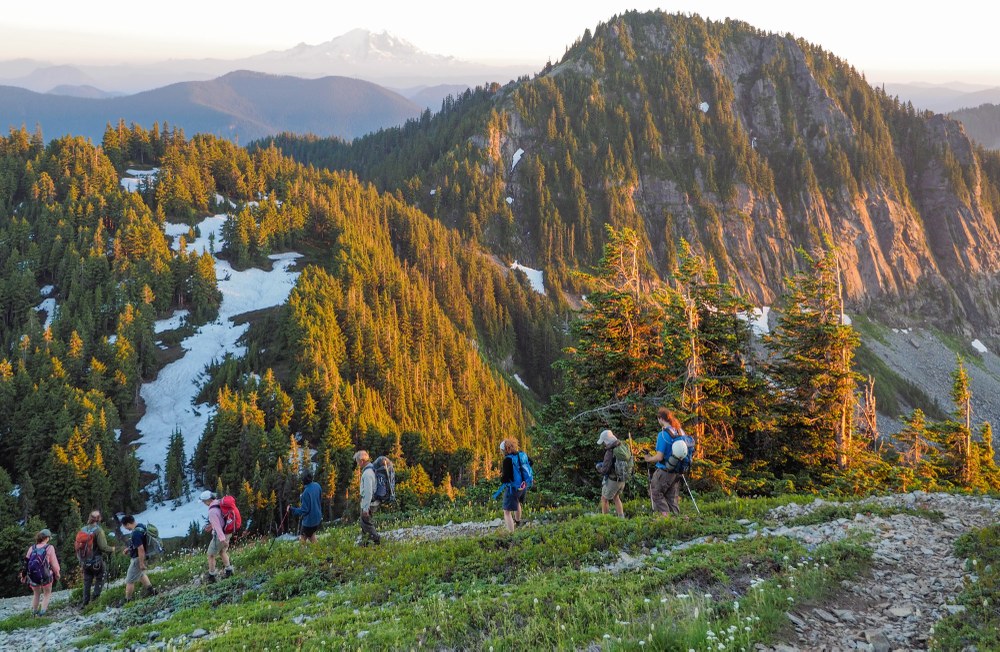
Last year, the outdoor community celebrated the passage of the Great American Outdoors Act (GAOA), the most significant federal conservation funding bill in decades. This historic victory was the result of years of work by The Mountaineers and many of our partners in the conservation and recreation community.
As the legislation was working its way through Congress, we asked Mountaineers to contact policymakers and voice support for public lands. You stepped up in a big way: nearly 1,500 of you reached out to your legislators in support of GAOA. As a result, the bill passed Congress with sizable majorities and was signed into law.
There are two major pieces of the Great American Outdoors Act: full and permanent funding for the Land and Water Conservation Fund (LWCF) and new funding to maintain and restore parks and public lands. In total, the bill means billions of dollars per year for public lands, outdoor recreation, maintenance and restoration, and new green spaces.
You might remember that last summer we explored the question of what the Great American Outdoors Act means for Washington. Now, we have more details about how the first year of this new funding for maintenance and restoration will be put to work locally. Read on as we dig into how the funding for deferred maintenance on federal public lands will be implemented in the places we play.
GAOA: Year One
The Great American Outdoors Act provides funding over five years for deferred maintenance and restoration of our national parks, national forests, and other public lands. This funding comes from offshore oil and gas drilling, not taxpayer dollars. As we’ve written about before, our public lands are woefully underfunded. Land management agencies face significant maintenance backlogs, which result in poorly maintained trails, potholed roads, and overflowing toilets. GAOA intends to help fix these problems by providing an infusion of funding to address the most urgent maintenance backlogs.
Recently, the Forest Service announced the first year of GAOA deferred maintenance projects. In 2021, $40 million will be invested in national forests across Washington and Oregon. Improvements will also be made to Mount Rainier National Park and other federal public lands. These investments will improve recreational facilities like trails and campgrounds, develop more sustainable infrastructure, build climate resiliency, and help address increased visitation. Subsequent funding will be announced in the upcoming years.
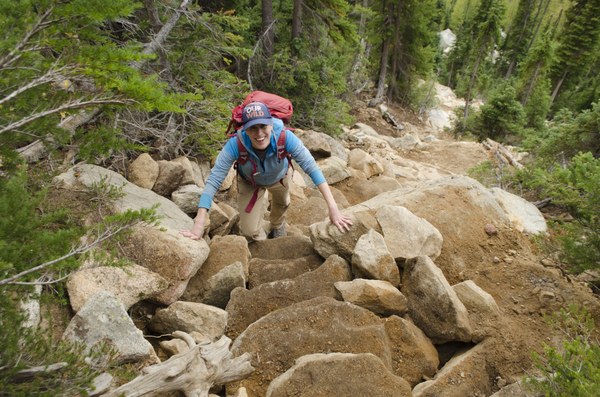 Katherine hollis climbing up a newly maintained trail in the okanogan-wenatchee national forest. photo by peter dunau.
Katherine hollis climbing up a newly maintained trail in the okanogan-wenatchee national forest. photo by peter dunau.
It’s important to remember that this funding isn’t going to solve all of the issues we see on our public lands. First, these funds are directed towards tackling the maintenance backlog, not creating additional recreation opportunities. And while GAOA provides significant funding, it’s still not enough to address all of the needs. However, it’s still tremendously exciting to see these investments start to happen after years of advocacy.
Here’s a few ways this funding will start to make a difference this year.
I-90 Corridor
Thanks to close proximity to urban areas, trails and recreation sites along the I-90 corridor are heavily used year round. The Mt. Baker-Snoqualmie and Okanogan-Wenatchee National Forests have teamed up on a package of investments to high-visitation trailheads, trails, day use sites, and campgrounds along I-90. This project will complete the Denny Creek/Franklin Falls trailhead expansion, adding an additional 40 parking spots. It will significantly improve the trails accessed from the trailhead, which are well loved by families and people of all ages and abilities.
Several of the most popular trails in the I-90 corridor - Annette Lake, Snow Lake, Denny Creek, and Franklin Falls - will receive significant improvements, bringing the trails back to good condition. These heavily-used trails need a lot of love to make them safe and sustainable for future generations. Washington Trails Association and Mountains to Sound Greenway Trust trail crews will reconstruct switchbacks and trail tread; create better drainage to prevent muddy, puddle-filled trails; and improve trail and trailhead signage. Improving these trails will also enable the Forest Service to focus their resources towards other locations.
2021 GAOA funds will also improve popular campgrounds such as Tinkham Campground near North Bend, Wish Poosh Campground in Cle Elum, and Kachess Campground near Snoqualmie Pass. These improvements will include complete reconstruction, establishing ADA access, and installing bear proof food containers.
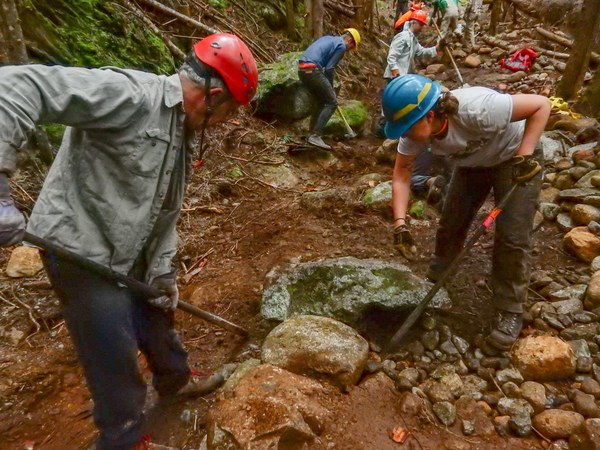 Mountaineers conducting trail maintenance in the Mt. Baker-snoqualmie national forest. photo by norm buckley.
Mountaineers conducting trail maintenance in the Mt. Baker-snoqualmie national forest. photo by norm buckley.
Mountain Loop Highway
The Mountain Loop Highway is another popular destination for hikers, climbers, skiers, and other recreationists due to its proximity to urban areas. 2021 GAOA funds will re-establish access to the Big Four Ice Caves, which has been inaccessible due to a washed-out bridge. The bridge and elevated boardwalk will be replaced, allowing visitors to once again get a great view of the massive Big Four Mountain, waterfalls streaming down the cliff face, and of course the famous snow caves. Funding will also be used to upgrade toilets and decommission failing outhouses along the corridor, resulting in more sustainable facilities and better water quality.
In future years, the Mt. Baker-Snoqualmie National Forest intends to use GAOA funds to improve popular trails like Heather Lake, Lake 22, and Mt. Pilchuck. The Forest also plans to enhance habitat and ecosystems for threatened species.
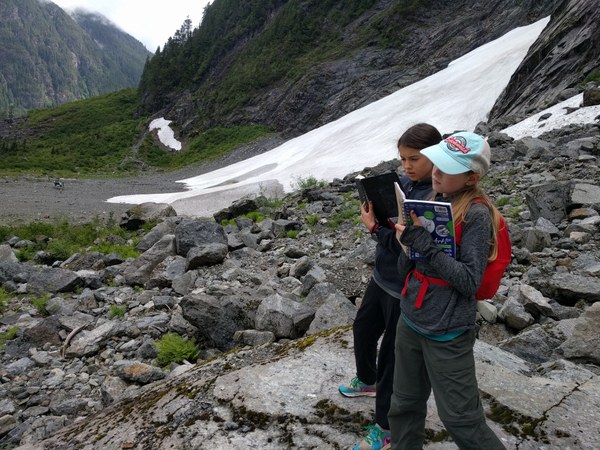 seattle mountaineers explorers on a naturalist hike to the big four ice caves. photo courtesy of jule gust.
seattle mountaineers explorers on a naturalist hike to the big four ice caves. photo courtesy of jule gust.
Icicle Creek Canyon
The Icicle Creek Canyon area outside of Leavenworth is prized for world-class rock climbing, access to the Enchantments, and spring wildflower hikes. The spectacular recreational opportunities bring a tidal wave of visitors, so the area is overdue for trail and road work. Thanks to GAOA, the Okanogan-Wenatchee National Forest is planning a number of maintenance projects in the corridor.
In partnership with trail crews, they plan to improve popular trails like the Pacific Crest Trail, Hatchery Creek, Chiwaukum Creek, Lower Icicle Ridge, Fourth of July, Snow Lakes, Colchuck Lake, and several others. Hikers will get a smoother ride on their way to those trails as well, with improvements planned to Icicle Canyon, Derby Canyon, Eagle Creek, Entiat River, and Stuart Lake Roads. Campgrounds along the corridor like Eightmile and Bridge Creek will get bear boxes and fire rings, improving wildlife and wildfire safety.
Mount Rainier National Park
Like the Forest Service, the National Park Service gets its own pot of money from the Great American Outdoors Act. For Washington’s National Parks, that could mean $427 million in improvements, including $186 million at Mount Rainier, $126 million at Olympic, $31 million at North Cascades, and significant sums at Ebey’s Landing, Fort Vancouver, and others. These treasured places are some of the most visited parks in the nation, and they are sorely in need of some TLC.
This year, Mount Rainier National Park received GAOA funding for two major projects: rehabilitating the Ohanapecosh campground and fixing nearly 9 miles of the 19-mile Stevens Canyon Road. Ohanapecosh, the largest of the park’s three campgrounds, will also get its sewer collection system replaced. Stevens Canyon Road, the sole east-west access across the park, runs between Paradise and the southeast entrance to the Park. This is the final phase of the road project and will improve the driving surface of the roadway and ensure its longevity.
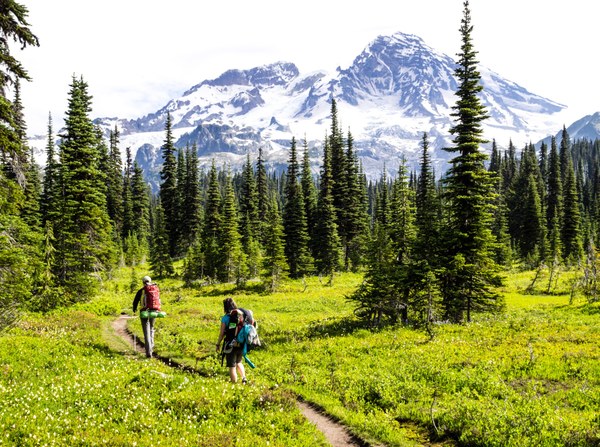 mountaineers backpacking in mount rainier national park. photo by david bradley.
mountaineers backpacking in mount rainier national park. photo by david bradley.
What’s Next?
The first year of the Great American Outdoors Act funding is directed towards projects that are “shovel ready” and can be implemented quickly. In subsequent years, federal land managers have more time to gather public input and plan for the future. The Mountaineers will be working closely with our partners to help ensure that your voice is heard as we ensure sustainable recreation access for years to come.
While we don’t know exactly what projects will be funded in future years, we could see improvements to the Heather Meadows recreation area near Mount Baker, expansion of the Lake Serene Trailhead, and reconstruction of the Milk Creek Bridge, a key missing link for access to the Pacific Crest Trail and the Glacier Peak Wilderness.
Closures
Unfortunately, trail and road work means closures. There’s no way to avoid it: in order to make needed repairs and improvements to trails, roads, and campgrounds, land managers will need to close popular areas for a certain period of time. We don’t know exactly when these closures might happen, but it’s safe to assume that some of the places detailed above might be closed this summer and fall. It’s a short term price we’ll have to pay in order to get beautiful, well-constructed trails for years to come.
Curious about what other places will see improvements thanks to the Great American Outdoors Act? The complete list of 2021 projects funded in Washington and Oregon can be found here. Expect to see more information coming out from federal land managers in the coming months.
Cover photo of mountaineers members enjoying an evening scrambling trip in the mt. baker-snoqualmie national forest. photo by david bradley.
Add a comment
Log in to add comments.Awesome, thanks for posting this! Looking forward to see what the ~200 million can do at Rainier.
 The Mountaineers
The Mountaineers